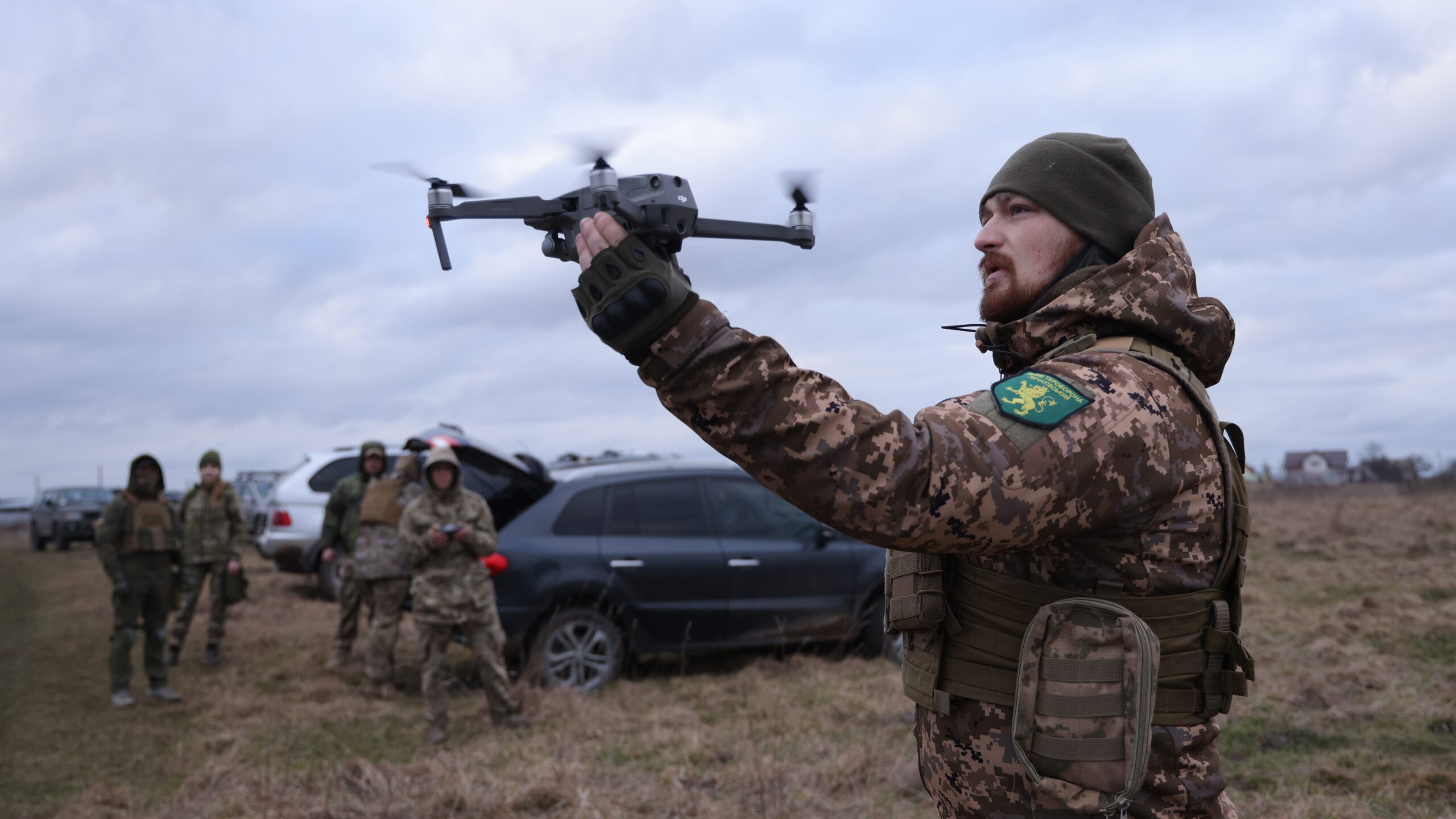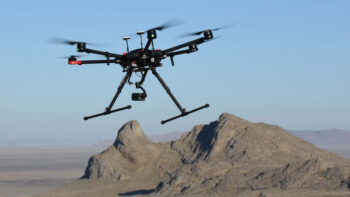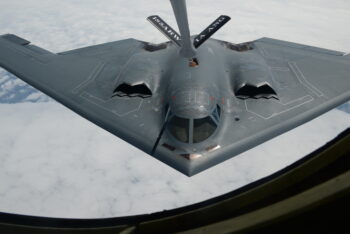
Ukrainians train with handheld drones. (Photo by Sean Gallup/Getty Images)
WASHINGTON – What high-tech weapons really work? What tactics make the difference between victory and death? There’s no test like the test of battle, and the US military has been watching the war in Ukraine with a keen and anxious eye. It’s another question whether the Pentagon bureaucracy is learning the right lessons about cheap drones, real-time intelligence-sharing and the weaponization of the Internet.
The dramatic defeats and victories of 2022 have settled in 2023 into a slow-motion meatgrinder, a conflict where cutting-edge technology combines with brutal battles of attrition over minefields and trench lines. Like the Malayan Emergency before Vietnam, the Spanish Civil War before World War II or the Russo-Japanese War before World War I, Putin’s bloody debacle in Ukraine is full of warnings for the next big conflict we all hope won’t ever come. But if it does come, the US had better have heeded at least these five lessons:
[This article is one of many in a series in which Breaking Defense reporters look back on the most significant (and entertaining) news stories of 2023 and look forward to what 2024 may hold.]
1. The cloud, fiber optics and hiding in basements: Army races to adapt to new command post threats
Over more than a decade of guerrilla warfare in Afghanistan and Iraq, American commanders got used to large, lavishly equipped Forward Operating Bases blessed with everything from Burger Kings to live video feeds from surveillance drones. As early as 2016, then-Chief of Army Staff Gen. Mark Milley warned such big, static targets would not last long against a well-armed foe with their own scout drones and long-range artillery. But it took Russia’s 2022 invasion of western Ukraine to drive the point home. Battlefield lessons began informing official Army doctrine and driving decisions on procurement of command, control, and communications gear.
This past May, the three-star chief of the Combined Arms Center, Lt. Gen. Milford Beagle, and two of his subordinates published a Military Review article that grimly called Ukraine “The Graveyard of Command Posts.” I talked to Beagle and his team for more about their dark vision of the future battlefield and how to survive it. Their ideas ranged from cutting-edge technology, like moving non-essential data from bulky “tactical servers” to the cloud, to old-school soldiering tricks, like hiding your command post in the basement of a rubbled building.
“This is something I think all armies are going to wrestle with,” Beagle told Breaking Defense. “The US Army certainly has. [But] we can better protect ourselves, reduce risk, even with the technologies that are emerging out there currently.”
2. Dumb and cheap: When facing electronic warfare in Ukraine, small drones’ quantity is quality
High tech doesn’t always mean high cost. One of the most striking developments in Ukraine — popularized by propaganda videos from both sides — is the ubiquity of drones. But as anti-aircraft defenses and electronic warfare units adapted to the threat, both sides moved away from the larger drones like the Turkish Bayraktar TB2, with its 40-foot-wingspan, towards smaller drones, even Chinese DJI Mavics less than 10 inches wide, that were both harder to target and cheaper to replace. One report estimated that Ukraine alone was losing up to 10,000 drones a month, mostly to Russian jammers disrupting their remote control links.
Even so, five independent experts agreed that it was still more cost-effective to buy cheap drones in bulk and treat them as essentially disposable, rather than try to upgrade them with better defenses against electronic warfare, let alone physical gunfire. “Commercial quadcopter and FPV [First Person View] drones are treated as expendable munitions,” said Samuel Bendett of CNA. “It’s not cost-effective to proof them against EW.”
That’s a hard lesson for the US procurement bureaucracy to learn. “We are losing out on the requirement to get these systems into the hands of soldiers at every echelon,” said retired US Army two-star Patrick Donahoe. “It’s got to be expendable.”
3. Ukraine War: Vast hacker ‘militias’ do little damage – but can rally mass support, says study
How did so much video of Ukrainian battles get into all our social media feeds in the first place? In large part because both sides crowdsourced propaganda — once the business of state bureaucracies and government-friendly corporate giants — by mustering millions of supporters online to edit, distribute and hype up their combat footage. Just as ubiquitous, cheap drones played a major role in collecting unprecedented quantities of video from the war zone, ubiquitous, cheap internet access (and video editing tools) played a major role in distributing it.
So the internet has become a major tool of wartime mass mobilization in the 21st century, just as then-novel media like radio and newsreels were in World War II. But mass mobilization has its limits, then and now. It’s a lot easier to make people feel like they’re participating in the great crusade than to turn their well-intentioned efforts in practical impacts on the battlefield. That said, sometimes people’s feelings are the point: Public morale has been a make-or-break-it factor in conflicts as different as World War I and Vietnam.
In May, the Center for Strategic & International Studies released a 64-page report bundling research from US and European scholars that delved deep into Ukrainian and Russian efforts to raise “IT armies” and hacker militias. While these groups’ hacks have been technically crude and dubiously effective, contributor Erica Lonergan wrote, “the act of collectively conducting relatively simple cyberattacks thus builds and reinforces community, providing something around which to rally and energize supporters.”
4. Ukraine and industry show how Europe can jump ahead on JADC2, ex-generals say
Joint All-Domain Command & Control, or JADC2 — occasionally seen with a “C” at the beginning to add “Combined”— is the Defense Department’s all-encompassing acronym for a future communications system linking all the armed services and, when “combined,” US allies. Aided by artificial intelligence, JADC2 would let units across land, sea, air, outer space and cyberspace (the five “domains”) share targeting data and coordinate strikes in near-real-time.
Actually building such a meta-network has proven a tremendous technical and organizational challenge, although the Air Force, Space Force, Army and (most secretively) the Navy all have conducted intriguing experiments. Yet it’s Ukraine that has actually implemented, in combat, the rapid digital sharing of targeting data from “sensor to shooter,” from a surveillance drone or human observer to an artillery battery or missile launcher. The role of Elon Musk’s Starlink satellites in relaying this kind of targeting data is well known. But, the Ukrainians also get at least some guidance from Western intelligence agencies, drawing on their own vast networks of air and space surveillance assets, and Ukraine routinely uses Western software, much of it provided free or bought “off the shelf” from friendly foreign firms.
In some ways, Ukraine’s lack of established “legacy” equipment has given it an advantage over the US, argued the former vice-chairman of the Joint Chiefs, retired Gen. James “Hoss” Cartwright. “We have a legacy force that needs to be brought forward,” he said. “You can’t just say, you know, wave your hand and it’s all of a sudden digital. It doesn’t work that way. That is tens of billions of dollars [and] probably ten years to do it effectively.”
5. Cyber lessons from Ukraine: Prepare for prolonged conflict, not a knockout blow
Putin is far from the first head of state seduced by the siren of a short, victorious war won with a swift knockout blow. Men marched off to World War I boasting they’d be “home by Christmas.” But it wasn’t just Russian paratroopers and tanks that fell fatally short of their objectives in early 2022: It was Moscow’s vaunted cyber/electronic warfare forces as well.
In 2007, Russian hackers took much of Estonia offline, while in 2014, Russian electronic-warfare troops shut down Ukrainian military radios. The fear among many cyber pundits and US officials was of a “Cyber Pearl Harbor,” where Russia, China or some other sophisticated threat would hack into American or allied networks and bring both government agencies and critical infrastructure to a crashing halt.
Yet Ukraine proved it had learned from its own and others’ painful experiences with Russia and armored its digital backbone with extensive help from Western governments and tech firms. Putin’s hackers tried for a knockout blow but found themselves in a protracted slugging match with Ukrainian cyber warriors. In the words of Illia Vitiuk, cybersecurity chief for the Ukrainian Security Service (SBU): “If you have 12 rounds in a boxing match … we are in probably round eight now.”
“There’s been sort of this assumption … that there’s just going to be this massive, disruptive, decisive round of disruptions,” said Michael Martelle, a scholar at the National Security Archive. “The term ‘cyber Pearl Harbor’ just won’t die, even though it really needs to.”






















